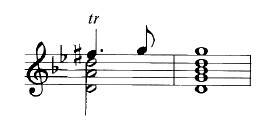
 |
| 返回首页/索引页 |
此部分共[5]页: 1>> 2>> 3>> 4>> 5>> 〖The Baroque Guitar (巴罗克时期的吉他音乐)〗 Editorial Policy The versions in this book are offered as performing scores, and differ in some respects from literal transcription intended for academic purposes. This is not to say that wild liberties have been taken with the tablature, but simply that it is recognized that the modern six-string guitar is not the same instrument as either the Baroque guitar or lute, and that changes have been necessary to accommodate the music of the Baroque instruments to the technical capabilities of the present-day guitar. At times this has involved expressing what appears to be the intention of the composer rather that the bare bones of the tablature, and a simple example will serve better than words to illustrate this point. In the works of Corbetta and his pupil de Visee, a cadence will frequently be found such as the following:  The second inversion of the concluding G minor chord is ugly and inconclusive to the ear, and would also have been considered so in the 17th Century. However the G below the staff that would complete the chord was simply not available on the Baroque guitar. Possibly a complete chord on the upper four strings was not considered strong enough; and possibly also the thumb was intended only to strike the upper octave of the pair of strings at the fifth course, omitting the lower D and simply doubling the higher one. But there is no way to know this from the tablature, and on many occasions the selection of only one of the pair of strings would still produce an imperfect chord. What we do know is that de Visee was embarrassed by such apparent solecisms in his guitar scores, and wrote that "the instrument itself is the reason." We also know that when he wrote for the lute with its many extra bass strings he never included this kind of unsatisfactory cadence. The solution is clearly to add the low G impossible on the Baroque guitar, or according to the demands of the piece to eliminate the low D, either solution being in my opinion correct to the intention of the composer if in a sense a change from what he wrote. In giving the above example it is not my intention to mystify the reader with the complexities of tablature, but simply to explain how it can be that the same piece of music can appear with slight differences when transcribed by different editors. Simple accompaniments for the songs have been derived from the figured basses of the original publications. These consisted of the bass line only, with numbers to indicate the required components of the chords although not their exact disposition. In some cases a simple bass line only was available. 此部分共[5]页: 1>> 2>> 3>> 4>> 5>> 〖The Baroque Guitar (巴罗克时期的吉他音乐)〗 |
Copyright:www.guitardyg.com@2009-2018 |